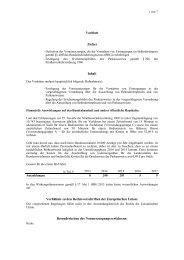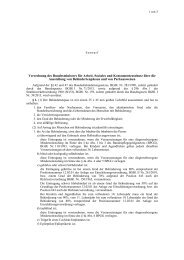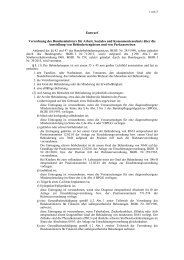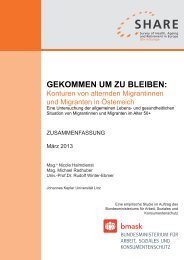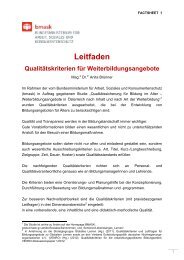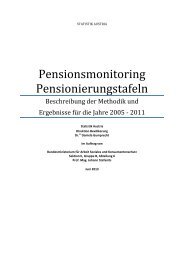Social Services of General Interest (SSGI)
Social Services of General Interest (SSGI)
Social Services of General Interest (SSGI)
You also want an ePaper? Increase the reach of your titles
YUMPU automatically turns print PDFs into web optimized ePapers that Google loves.
Eilmansberger/Herzig<br />
necessity <strong>of</strong> restrictions for the benefit <strong>of</strong> services <strong>of</strong> general interest, as far as there is<br />
evidence for a real need for public services and as far as such a service would not be<br />
sufficiently delivered in free competition. However, the concrete rule must be necessary,<br />
proportionate to secure the intended objective and based on objective and non-discriminatory<br />
criteria known in advance to the undertakings concerned. Case-law rulings on health services<br />
may be used to make inferences about the social sector. In respect <strong>of</strong> health services the Court<br />
<strong>of</strong> Justice has already held in several cases that the objective <strong>of</strong> maintaining a balanced<br />
medical and hospital service open to all may even fall within the derogations on grounds <strong>of</strong><br />
public health under Art 46(1) EC, in so far as it contributes to the attainment <strong>of</strong> a high level <strong>of</strong><br />
health protection. 74 Moreover, the Court <strong>of</strong> Justice has repeatedly held that securing the<br />
financial balance <strong>of</strong> a social security system constitutes in itself an overriding reason in the<br />
general interest. 75 If the restricting rules contribute to the attainment <strong>of</strong> these recognised<br />
objectives under Community law, they may be justified. For this purpose one needs to apply<br />
very stringent criteria <strong>of</strong> proportionality to prove that the rule in question does not restrict<br />
internal market rules more than necessary to attain the objectives in question. Authoritative<br />
clarification will frequently only be provided by ECJ rulings, a situation which burdens this<br />
sector with a great many unresolved questions concerning compliance <strong>of</strong> such rules with<br />
Community law. It would thus be advisable to consider how an act <strong>of</strong> secondary law could<br />
clarify the situation.<br />
For this purpose it will become necessary to define, as precisely as possible, the<br />
objectives to be attained by a restricting rule. The rules to be examined in the Hartlauer case 76<br />
can be used as an example. The criteria to be developed by the Court <strong>of</strong> Justice for testing<br />
justification will have to be transferred, mutatis mutandis, to other areas <strong>of</strong> the social sector as<br />
well. The rule’s objectives <strong>of</strong> providing comprehensive and high-quality medical services to<br />
the population, and controlling the resultant financial burden on the public purse, are still too<br />
general to serve as a basis for proportionality testing. The following sub-objectives could be<br />
pursued with this rule. 77<br />
For one thing, the rule is intended to protect the continued existence <strong>of</strong> public health<br />
services and/or, in the wider sense, publicly financed institutions providing health services;<br />
this is linked to the objective <strong>of</strong> controlling the financial burden generated by the healthcare<br />
system in that any protection against competition in favour <strong>of</strong> publicly funded institutions<br />
should ensure efficient use <strong>of</strong> public resources in this area. This protection <strong>of</strong> continued<br />
existence and against competition may also be seen in the context <strong>of</strong> the objective <strong>of</strong> ensuring<br />
territorial coverage <strong>of</strong> medical services to the population.<br />
Finally, any needs test rule may also make an additional contribution towards<br />
controlling the financial burden incurred by public authorities in healthcare. The limitation <strong>of</strong><br />
medical service delivery thus achieved, and/or the orientation <strong>of</strong> such delivery on existing<br />
demand thus made possible, might prevent the development <strong>of</strong> mainly supply-induced<br />
demand and thus limit the funding requirements for subsidising medical services in general<br />
(prevention <strong>of</strong> supply-induced demand).<br />
74 Case C-158/96, Kohll, ECR 1998, I-1931, par. 50; Case C-157/99, Smits and Peerbooms, ECR 2001, I-<br />
5473, par. 73; Case C-358/99, Müller-Fauré, ECR 2003, I-4509, par. 67; Case C-444/05, Stamatelaki, ECR<br />
2007, I-3185, par. 31.<br />
75 Case C-158/96, Kohll, ECR 1998, I-1931, par. 41; Case C-157/99, Smits and Peerbooms, ECR 2001, I-<br />
5473, par. 72; Case C-358/99, Müller-Fauré, ECR 2003, I-4509, par. 73; Case C-444/05, Stamatelaki, ECR<br />
2007, I-3185, par. 30.<br />
76 request for a preliminary ruling, pending as Case C-169/07, Hartlauer, OJ 2007 C 155/8.<br />
77 Same argument in Eilmansberger, Bedarfsprüfung (FN 60) with added references.<br />
20







